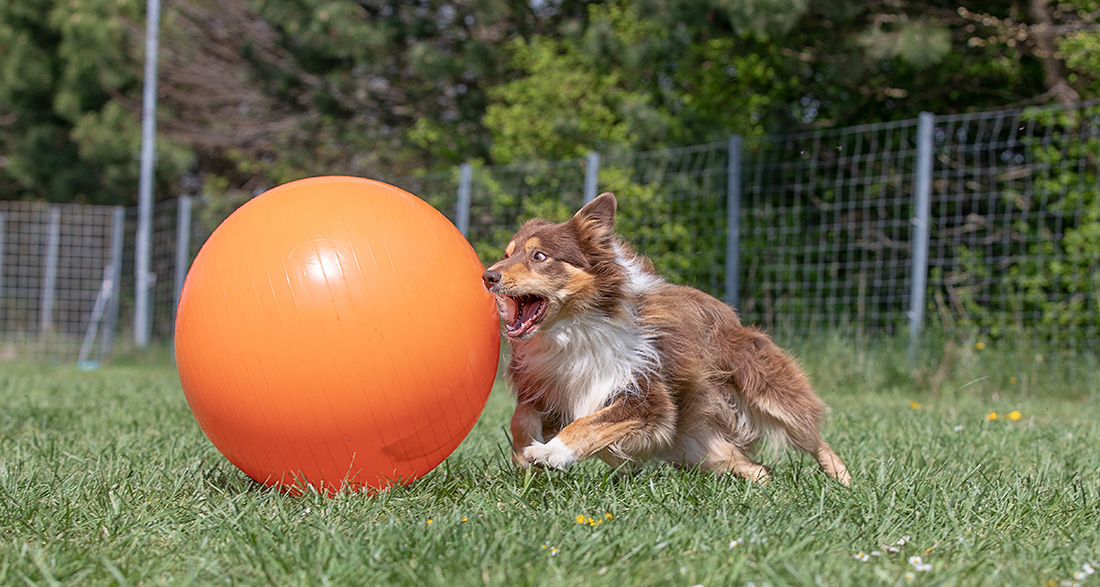Treibball is an ideal sport for dogs who have a special interest in challenging tasks and are real powerhouses. Energetic, agile, and nimble dogs will certainly have a lot of fun with Treibball training – and so will you. While Treibball revolves around large balls, it takes more than just nudging them with the nose to get them to the goal. Intrigued? Then let’s sniff around further.
Interesting Background on Treibball
Treibball is a unique dog sport developed by Jan Nijboer in 2003. The Dutchman initially worked as a social worker in the therapeutic field with behaviorally challenged individuals before professionally dedicating himself to training service dogs (assistance/therapy dogs). In his roles as a dog trainer, lecturer in animal management, and social worker, he developed “Natural Dogmanship.”
Nijboer’s new method of dog training combines insights from sociology, neurobiology, cynology, pedagogy, and communication science to constructively align dogs and dog owners with each other. At the core of the new training methods lies the dog’s inner motivation. The dog is not “persuaded” with treats or petting to do something but is presented with tasks that motivate them. External, so-called extrinsic motivations (treats) are avoided as much as possible. Natural Dogmanship aims to design training measures that consider the dog’s natural needs.
It’s fascinating how Mantrailer dogs can still sniff out the scent even after days have passed. Some experts are convinced that their Mantrailer dogs can even follow a human scent trail when the person being sought has driven away in a car.
Mantrailing provides a natural outlet for every household dog and is also a fascinating activity with one’s own dog. It’s no wonder that it’s increasingly popular as a dog sport in the private sector.
Treibball for Dogs – How Does It Work?
Treibball training takes place on a large grass field with a goal measuring 2 x 3 meters. Then you only need eight different-sized exercise balls and a playful, healthy dog. The exercise balls typically range in size from 45 to 85 centimeters. During a tournament, they are set up in a triangular formation on the field, similar to billiards, with the apex of the triangle pointing towards the goal. However, during Treibball training, you arrange the balls freely.
The dog’s task is to push all the exercise balls into the goal one after the other. The dog can use their snout, paws, and body to push, roll, and kick the balls. The dog receives support and instructions from you, their “handler.” Encouraging calls, commands, hand signals, and whistles are allowed. During the tournament, the handler stands next to the goal, instructing their dog. At the end of a run, the dog must go into the so-called “down” position parallel to the goal.
In the tournament, time is of the essence. Your dog must push all the balls into the goal within the prescribed 15 minutes. During Treibball training, you work closely with your dog as a team and run alongside them to the finish line. This way, Treibball brings lots of fun to both your furry friend and you. The strong orientation of Treibball towards the typical tasks of herding dogs is still evident in the names and functions of the equipment: the balls are called “sheep,” the field is the “pasture,” and the goal is, of course, the “gate.”
Which Dogs Can Train Treibball?
In principle, all healthy dogs can participate in Treibball if they have a certain size and robust body build. Your dog must be physically capable of maneuvering an exercise ball up to 85 centimeters in size over a longer distance into the goal. This may be challenging for a delicate Greyhound, a heavy-breathing Pug, or a small Dachshund.
Originally, dog trainer and educator Jan Nijboer developed Treibball for underexercised herding dogs, which now live in apartments as companion and family dogs. These dogs – especially Australian Shepherds and Border Collies – are prone to developing psychoses or becoming overactive due to the lack of species-appropriate exercise for their breed.
In general:
- While Treibball is ideal for herding dogs, all dogs that need a powerful, energetic activity “with brains” benefit from it.
- Training can be customized so that dogs with minor handicaps or older dogs can participate. However, this dog sport is geared towards dynamism and speed.
What Does Treibball Training Look Like?
The most important aspect of Treibball is that you and your dog become a team. Communication is crucial and will be perfected throughout the training. Commands play a significant role in Treibball. Your dog learns to understand complex concepts and quickly put them into practice.
- The first stage of training involves directing your dog’s attention to their task. Your dog must take the task and you as their partner seriously. They learn to herd the balls like sheep – that is, to treat them with care but also with determination.
- Therefore, never offer the balls to your dog as “prey.” From the beginning, discourage biting into the balls and playing with them. Use only soft exercise balls to prevent your dog from injuring their sensitive nose or head on hard balls (which unfortunately are also offered as Treibballs), which could lead to a loss of interest in ball pushing.
- Initially, training is done on a long leash and with a harness. Later, the dog acts without a leash using a target.
- To motivate the dog to nudge the ball for the first time, place a food dummy under the ball. However, according to the educational philosophy of its inventor, Treibball should be trained without external motivation, meaning without treats. Only at the end of the training session are the dogs rewarded from the food pouch.


